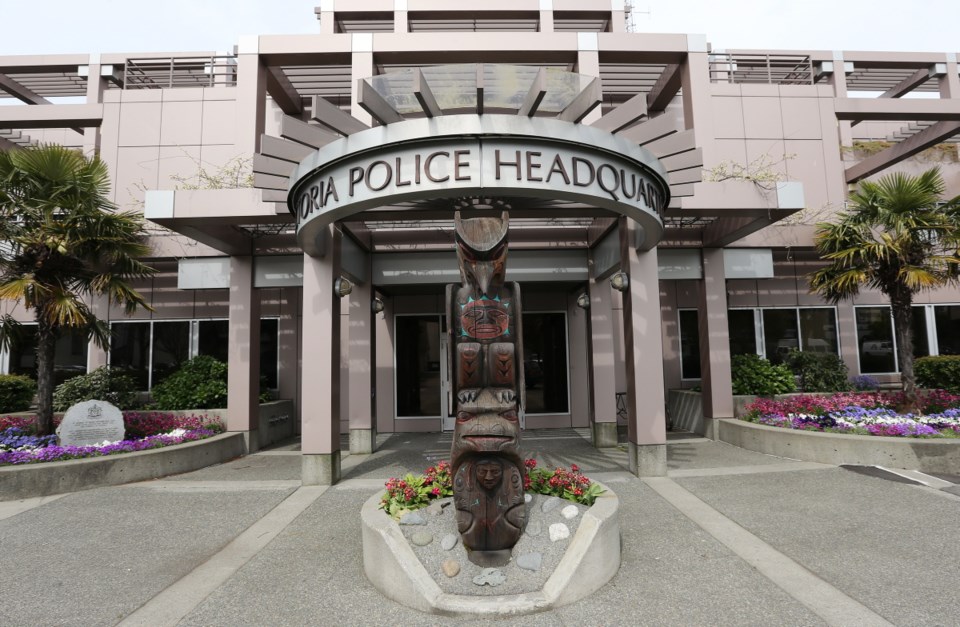 Here’s what you get when one police force has two masters: a budget soap opera, every year.
Here’s what you get when one police force has two masters: a budget soap opera, every year.
The Victoria Police Department is in a unique position. It is the only one of B.C.’s 11 municipal police departments that needs budget approval from two municipal councils. If either Esquimalt or Victoria doesn’t like a budget item, that item is dead, unless the other is willing to fund it alone.
The RCMP has plenty of multi-municipality detachments — for example, West Shore encompasses Langford, Colwood, View Royal, Metchosin and Highlands — but local politicians tend not to mess with their budgets, finding A) the Mountie monolith is hard to budge, B) it’s a bargain for taxpayers, so why bother and C) nothing would get done if individual councils tried to veto budget bits.
That’s the way it is in the rest of the country, too. Greater Victoria and Greater Vancouver are the only medium-to-large communities in Canada not served by a single police department. In those with a regional force — comparable would be the Niagara Regional Police Service, covering the half million people of Niagara Falls, St. Catharines and a handful of other southern Ontario municipalities — budget approval rests with the regional government. Individual councils don’t get a veto, they get a bill.
Not here in Dysfunction-By-The-Sea, where the VicPD car comes with two steering wheels and where, for the second straight year, an individual council has decided to leave the Victoria police board in the dust.
It’s the police board, which includes the mayors of Esquimalt and Victoria, that does the detailed scrutiny of the spending plan. The idea is to remove politics from the process.
Good luck with that. In 2018, after Victoria OK’d the hiring of six more officers conditional on Esquimalt’s approval, the latter voted to kill the idea. That resulted in the force moving six cops, including its three school-liaison officers, to front-line policing.
This year, it was Victoria city council’s turn to hit the brakes. In mid-February, it balked at raising the police budget enough to cover rising costs, including a $690,000 bill for B.C.’s new employer health tax. Since they were playing with $3.4 million in new revenue, councillors could easily have covered the health tax (as was the case with all the other local departments) but decided to spend the money on their own priorities.
Instead, council (with Mayor Lisa Helps among those unsuccessfully resisting) told the police board to come back with $858,000 worth of cuts, though it’s obvious councillors didn’t have the same grasp of the issues as the police board does.
Watching councillors try to micro-manage police spending — proposing to cut line items willy-nilly, only to back off after learning the depth of the cow pies into which they had marched — was like watching me give hair-styling tips.
Then, to complicate matters, the provincial government ruled last week that Esquimalt was wrong to reject the hiring of the six officers last year. (Note that this is the third time Esquimalt has suffered the indignity of having a policing decision overturned. It happened in 2003 when the province forced the shotgun marriage of the Esquimalt and Victoria departments, and in 2012 when it wouldn’t let Esquimalt get a divorce. Esquimalt should get a punch card: five decisions overturned and it wins a toaster-oven.)
That leaves VicPD in a pickle. If Victoria insists on the $858,000 reduction, that will equate to about nine positions. The hire-six-cops order from the province makes it clear that the department can’t chop officers and still meet the minimum standards mandated by the Police Act. That leaves the department’s 60-or-so civilian employees, but could VicPD function without its IT geeks, records clerks and other CUPE members? And by the way, where is the money for the six extra cops supposed to come from? Something has to give when Victoria council considers the matter again next week.
And that’s before Esquimalt gets its kick at the can.
Underlying it all is the fractured nature of local policing, and the imbalance in the way costs are shared. Victoria bears the weight of policing the region’s downtown, which is where so many of us go to work, play, get drunk and punch one another in the nose. If Esquimalt complains (and it does, jealously guarding the patrol dedicated to its seven square kilometres), it is because it is the only one of the capital region’s 13 municipalities to subsidize Victoria.
Policing cost Victoria residents $503 per capita in 2016. The figure for Esquimalt, which pays 14.7 per cent of the VicPD bill, was $440.
That compares with $297 in Saanich, $292 in Central Saanich and $270 in Oak Bay, the other capital region communities with municipal forces.
Those who live in Mountie municipalities pay less, in part because Ottawa shares the cost: $189 in Sidney, $198 in Colwood, $164 in Langford, $132 in North Saanich, $150 in Sooke and $158 in View Royal.



